

 Below is the blue mold status report for July 7. After it went
to press, the Lexington Lab confirmed active blue mold in
Pulaski County, Kentucky. Most of the blue mold was from
old lesions that had been present several weeks on sucker
regrowth, but new lesions with new sporulation was
occurring. Thus, the areas under a blue mold watch have been
expanded.
Below is the blue mold status report for July 7. After it went
to press, the Lexington Lab confirmed active blue mold in
Pulaski County, Kentucky. Most of the blue mold was from
old lesions that had been present several weeks on sucker
regrowth, but new lesions with new sporulation was
occurring. Thus, the areas under a blue mold watch have been
expanded.
Fields should be scouted at least twice weekly for blue mold, checking stunted plants carefully for systemic blue mold by cutting into the stems, especially near where leaves have dropped and near the soil line. Systemic blue mold can take on many appearances, but it usually includes discoloration of the vascular system (especially the phloem and cambial tissues) of stem, buds, leaves or roots - along with any of the following symptoms: general yellowing, stunting, plant distortion, narrowed leaves, mottled leaves, and darkened roots. The susceptibility of tobacco crops is highly variable about the state and within each community. Shady sites with rapidly growing tobacco (either the main plant or its ground suckers) are the most likely places to find sporulating blue mold in the field. Abandoned plant beds are also likely sites to have blue mold. Should sporulating lesions of blue mold be found within a county, weekly fungicide spray programs with Acrobat MZ should be immediately put in place, to check sporulation, followed by activation of the plant with Actigard 50W once the plants are 18 inches tall and able to tolerate the treatment. Additional sprays of Acrobat MZ may also be needed later in the season after the second application of Actigard if strong blue mold pressure is present, especially for late-maturing varieties.
Application guidelines for the fungicides labeled for blue
mold control in the field in Kentucky can be found in
Kentucky Pest News, April 28, 2003 issue number 983 at web address -
http://www.uky.edu/Agriculture/kpn/kpn_03/pi030428.htm
For the latest blue mold status and other tobacco disease information, check the KY Blue Mold Warning System online.
![]() http://www.uky.edu/Agriculture/kpn/kyblue/kyblue.htm
http://www.uky.edu/Agriculture/kpn/kyblue/kyblue.htm
 While they don't make the "Top 5 Pests" list for the crop,
three worms and a beetle, can be found in or on tobacco
now. Here us a quick look at them with some comments on
damage potential.
While they don't make the "Top 5 Pests" list for the crop,
three worms and a beetle, can be found in or on tobacco
now. Here us a quick look at them with some comments on
damage potential.
The common stalk borer can cause yellowing and wilt that ranges from individual leaves to entire plants. Usually, affected plants occur randomly in border rows, or along grassy drive ways or waterways. The wilting or yellowing results from disruption of water and nutrient movement due to tunneling of a stalk borer larva into a leaf midrib or the main stalk. An entry hole often can be found and the distinctive larva is within the tunnel. Small larvae are cream colored with a dark brown or purple band around the body near the front end. Several light stripes run the length of the body. Full grown larvae may lack the dark stripes and band, making them harder to identify. Stalk borers move from grasses that have become too small to contain the into the first plant they find as they crawl along the ground. Common stalk borers occur in the plant where they are protected from an insecticide application. Fortunately, few plants and infested and the borers do not tend to leave a plant once they have entered it.
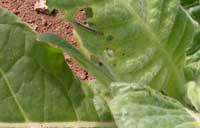
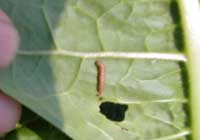 The yellowstriped armyworm and variegated cutworm can
be found on tobacco foliage. The distinctive yellow side
stripes make the yellowstriped armyworm easy to recognize.
Generally, only individual larvae are found on scattered
plants and they do only a small amount of feeding. Several
grey-brown variegated (or climbing) cutworms can be found
on a single plant and they can take a healthy bite. The
variegated cutworm has a row of single light spots down the
center of the back. Like the yellowstriped armyworm, there
usually are only a few infested plants in a field and control is
not justified.
The yellowstriped armyworm and variegated cutworm can
be found on tobacco foliage. The distinctive yellow side
stripes make the yellowstriped armyworm easy to recognize.
Generally, only individual larvae are found on scattered
plants and they do only a small amount of feeding. Several
grey-brown variegated (or climbing) cutworms can be found
on a single plant and they can take a healthy bite. The
variegated cutworm has a row of single light spots down the
center of the back. Like the yellowstriped armyworm, there
usually are only a few infested plants in a field and control is
not justified.
Japanese beetles are moving about now and can be seen
sitting on tobacco leaves. They do not feed regularly on
tobacco but occasionally a mass of them will attack a plant or
two in the field. They shred the leaves with their tiny feeding
holes but widespread damage has not been a problem in
Kentucky tobacco fields.
See "Insect Management Recommendations" for more insecticide recommendations on tobacco and other crops and livestock.

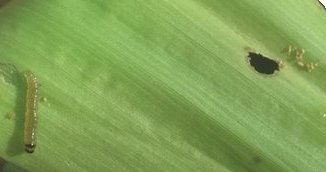 Moth from the first generation European corn borer are active
across the commonwealth. Egg laying for the second
generation will be continuing for the next several weeks. In
particular, growers should monitor late planted corn for corn
borer egg laying. Experience with Bt corn has shown us the
potential losses that can occur from late-season corn borer
attack in standard hybrids. For a guide on European corn
borer scouting thresholds and decision guidelines, see ENT-
49, European corn borers in corn or "Insect Management
Recommendations".
Moth from the first generation European corn borer are active
across the commonwealth. Egg laying for the second
generation will be continuing for the next several weeks. In
particular, growers should monitor late planted corn for corn
borer egg laying. Experience with Bt corn has shown us the
potential losses that can occur from late-season corn borer
attack in standard hybrids. For a guide on European corn
borer scouting thresholds and decision guidelines, see ENT-
49, European corn borers in corn or "Insect Management
Recommendations".
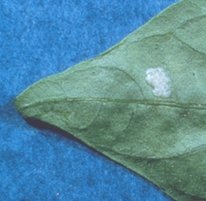 Southwestern corn borer egg laying generally lags behind
that of European corn borer by two to three weeks. So corn
producers should expect egg laying by the first generation
southwestern corn borer moths to begin shortly. The
potential for harvest losses in late planted corn due to
southwestern is significant. Producers should monitor
these late planted fields closely, identify the most heavily
infested fields and schedule them for the earliest practical
harvest to avoid these late season harvest losses.
Southwestern corn borer egg laying generally lags behind
that of European corn borer by two to three weeks. So corn
producers should expect egg laying by the first generation
southwestern corn borer moths to begin shortly. The
potential for harvest losses in late planted corn due to
southwestern is significant. Producers should monitor
these late planted fields closely, identify the most heavily
infested fields and schedule them for the earliest practical
harvest to avoid these late season harvest losses.
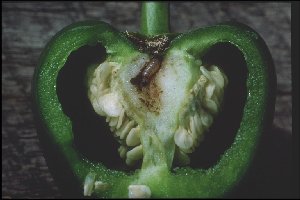 Pepper growers will also need to manage European corn
borers during the next few weeks. Insecticides for corn
borer control will need to be selected carefully in order to
avoid secondary outbreaks of green peach aphid and to
comply with the mandatory preharvest intervals. The
preharvest intervals can vary from 0 to 7 days depending
on the type of insecticide used for corn borer control.
Pepper growers will also need to manage European corn
borers during the next few weeks. Insecticides for corn
borer control will need to be selected carefully in order to
avoid secondary outbreaks of green peach aphid and to
comply with the mandatory preharvest intervals. The
preharvest intervals can vary from 0 to 7 days depending
on the type of insecticide used for corn borer control.
For more information about corn pests, visit "Insect Management Recommendations".
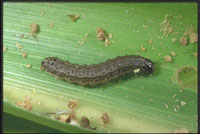 With much of the corn planted late this spring, growers
should monitor their whorl stage corn for fall armyworm.
Fortunately, fall armyworm numbers have been low, but
some corn fields may stay in the whorl stage through the
end of July.
With much of the corn planted late this spring, growers
should monitor their whorl stage corn for fall armyworm.
Fortunately, fall armyworm numbers have been low, but
some corn fields may stay in the whorl stage through the
end of July.
Fall armyworm cannot overwinter in Kentucky and must invade the state from overwintering sties along the gulf coast each summer. It prefers to attack whorl stage corn, and in most years usually does not reach damaging levels until corn has tasseled. Because of the late planting, corn will stay vulnerable to fall armyworm attack much longer this summer.
Fall armyworm can be a difficult insect to control with insecticide sprays. As with European corn borer, timing is critical for effective control. Small larvae feed in the whorl and are relatively easy to control. But older larvae expel large amounts of frass into the whorl which forms a plug and limits penetration of insecticides deep into the whorl.
Many growers used Bt corn with their late plantings to avoid problems with corn borers. But the Bt corn used by growers only suppresses fall armyworm feeding. Late- planted Bt corn will still need to be monitored for fall armyworm this summer.

During the past week or two, many alfalfa fields have been exhibiting yellowing of foliage. There are several possible causes for these symptoms.
Leaf spot diseases. Several leaf spotting diseases--including Lepto leaf spot and summer black stem & leaf spot-have been diagnosed recently in alfalfa. The very wet weather of spring and early summer favored activity of leaf spotting diseases in first and second cuttings. Leaf spots and blights weaken the plant but alfalfa usually outgrows the damage in later cuttings. Maintain a regular cutting schedule, cutting at 30- to 35-day intervals.
Potato leafhopper. Potato leafhoppers appear to be very active in Kentucky alfalfa fields. Information on recognition, scouting, and control are available from UK's Entomology Extension program. See http://www.uky.edu/Ag/IPM/scoutinfo/alfalfa/insects/plh/plh1.htm or your county Extension office.
Soil compaction. Wet soils this spring during preplant operations or hay harvesting operations have resulted in severe compaction in some fields. Check for soil compaction by digging and examining both root systems and soil structure. If the compaction is so severe that the tap root cannot pass through the compacted zone, yields will be reduced significantly and plowing and replanting might be the only option. Remember, it is much easier to prevent than to alleviate soil compaction.
Potash deficiency. High quality alfalfa removes a large amount of potassium from the soil each year. Soil test K levels should be monitored closely and fertilizer K should be applied whenever it is recommended. It is possible that some plants in your field may exhibit mild potash deficiency symptoms even if potash levels in the soil are adequate, since roots that are limited by compaction and/or root rots will be less effective at taking up potash. Maintaining soil test levels and preventing soil compaction will help to assure maximum productivity and stand longevity.
Root rots. There are a variety of root-rotting diseases of alfalfa that are favored in the saturated soils commonly experienced in May and June. The most damaging is Phytophthora root rot; which can attack any part of the root system of plants of any age. Aphanomyces and Pythium fungi are also known to attack the fine feeder roots of mature plants of alfalfa when soils are saturated. Always select varieties with R or HR ratings to Phytophthora and Aphanomyces root rots when seeding alfalfa in Kentucky. Unfortunately, there is no known resistance in commercial cultivars to Pythium infection, but improving soil drainage and minimizing soil compaction will help with all three diseases.
Poor nodulation. Check nodulation of new seedings by carefully digging and washing root systems and examining for nodules. Poor nodulation of roots may be the result of root-rot infections or of poor viability of the Rhizobium bacterium on the seed. If poor viability on the seed is the cause, an inexpensive practice to improve the chances for nodulation can be found at: http://www.ca.uky.edu/agcollege/plantpathology/PPAExten/PPFShtml/ppfsagf4.htm.
Crown rot diseases. Dig plants and cut into the crowns. Those that are showing brown discoloration are exhibiting crown rot. We've seen Rhizoctonia crown rot in recent alfalfa samples, which was undoubtedly favored by the unusually wet soil surface conditions experienced earlier this season. Adapted varieties of alfalfa can sometimes recover from crown rots. However, if severe, crown rots can be a significant problem for long-term health of the stand. Thus, if you see a high frequency of crown rot in a particular field, that is usually a flag to rotate.
Probably the best indication of when to rotate is stand
density. Approximate guidelines as to economically
acceptable stands from Dr. Garry Lacefield, UK Forage
Agronomist, are:
3 crowns per square foot for hay
1 crowns per square foot for grazing
Dr. Lacefield points out that these are approximate
guidelines. For example, a beef cattle producer often will
meet his/her production goals well with a much lower
density of alfalfa crowns than a hay producer. He also
indicates that, for the Upper Midwest, for high-quality
dairy hay productions, the standards are based on stem
density, since this more closely correlates to forage
production than crown density.:
55+ stems per square foot: no yield reduction
40-55 per square foot: some yield reduction
Below 40 per square foot: give consideration to replanting
If stands are less than needed for your yield goals, plan a rotation away from alfalfa followed by re-seeding.
See Insect Recommendations for more alfalfa pest recommendations.
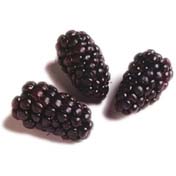 Blackberries are native to Kentucky and readily grow in the
wild statewide. Because they grow wild, there is a
tendency to regard them as an easy crop to grow and to not
be aware of their potential disease problems. Recent
laboratory and field observations of devastating blackberry
diseases in Kentucky are a reminder that growers need to
be aware of the several blackberry diseases that could
require attention if they are grown commercially.
Blackberries are native to Kentucky and readily grow in the
wild statewide. Because they grow wild, there is a
tendency to regard them as an easy crop to grow and to not
be aware of their potential disease problems. Recent
laboratory and field observations of devastating blackberry
diseases in Kentucky are a reminder that growers need to
be aware of the several blackberry diseases that could
require attention if they are grown commercially.
Anthracnose and Cane cankers. Fungi such as Elsinoe veneta, Leptosphaeria coniothyrium, and Botryosphaeria dothidea can attack the cane, often made more susceptible by injury the previous winter, or by spring frost or drought. These fungi cause lesions and cankers that can girdle the canes and cause them to die. Infected canes commonly become cracked and brittle and break easily. Many of the upright Arkansas selections are not very cold hardy and may be more susceptible to cane canker diseases.
Orange rust. This disease, caused by the fungus Arthuriomyces peckianus, is the most important of several rust diseases of blackberry. Infected plants can be easily identified shortly after growth appears in spring when newly formed shoots appear weak and spindly. The new leaves on such canes are stunted or misshapen and pale green to yellowish. In a few weeks, the lower surface of infected leaves are covered with waxy, bright orange blister-like pustules. Blackberries are infected systemically and will bear little or no fruit. Orange rust is widespread on Kentucky wild blackberries.
Rosette (double blossom). This devastating disease is caused by the fungus Cercosporella rubi. Symptoms usually consist of weakly growing, but proliferating leafy sprouts called witches brooms. Flower buds are abnormally enlarged and flowers may be deformed. Rosette-infected blossoms do not form berries and other parts of the cane may produce poor quality fruit.
Phytophthora root rot. This disease is caused by one or more species the fungus Phytophthora which lives in the soil and causes a decay of blackberry roots and lower stems. The leaves of the plant may wilt, canes may be stunted, and plants may die. Once plants become infected, they may die quickly or they may decline gradually; they rarely recover from this disease. The fungus is a "water mold," and is thus favored by wet soils.
Verticillium wilt. The soilborne fungus, Verticillium alboatrum causes this serious wilt of blackberries. Depending on variety, blackberries may suffer severe losses or merely poor growth. Symptoms appear in mid-summer as lower leaves begin to turn yellow and wilt.
Blackberry virus diseases. Little is known of the kinds of viruses that might affect blackberries in Kentucky. Some blackberry viruses can reduce yields by causing sterility or production of seedy, crumbly fruit while others may simply weaken the plants so that they are more susceptible to other diseases.
Disease management.
In most parts of Kentucky, only one or two of these diseases are a cause for concern and these diseases can be managed with diligent effort. However, in some Kentucky locations three or four of these diseases are chronically present making successful blackberry growing in these locales very difficult. Growers are often reluctant to use fungicides on blackberries because sprays add expense to a crop that one might think would not need many sprays. Growers need to assess their growing circumstances when committing to blackberry culture.
Disease management advice can be found in U.K. Cooperative Extension Publication ID-94, Midwest Commercial Small Fruit and Grape Spray Guide 2003 and the Midwest Small Fruit Pest Management Handbook available at Kentucky County Extension Offices.

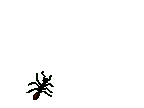 Many winged or swarmers of the pavement ant are coming
in for identification. Pavement ants are small, dark brown
ants that often nest along foundations, concrete slabs, or
sidewalks. They may move soil up through the cracks leaving
small surface mounds, which are helpful in locating
treatment spots. These ants also can nest under heavy mulch
and leaf litter.
Many winged or swarmers of the pavement ant are coming
in for identification. Pavement ants are small, dark brown
ants that often nest along foundations, concrete slabs, or
sidewalks. They may move soil up through the cracks leaving
small surface mounds, which are helpful in locating
treatment spots. These ants also can nest under heavy mulch
and leaf litter.
Pavement ants form trails to food sources which include a wide variety of items including dead insects, sweets, greasy foods, and pet food. Often they feed on the sweet liquid waste produced by aphids feeding on the leaves of nearby trees.
Workers found indoors are from outdoor colonies that may be right next to the house or located up to 30' feet away. They enter houses through cracks, weep holes, or under doors. Pavement ants can be found along the baseboards or around the base of toilets. They have stingers but are not aggressive in defending themselves. Winged swarmers can fly at most any time of the year and may move into buildings. Swarmers from colonies beneath floor slabs may enter the house directly and may give a clue as to where the infestation is. Swarmers can be vacuumed up and discarded.
The key to ending the problem is to locate the nest and treat it directly. Surface sprays of residual insecticides will only kill some wandering workers but not solve the problem. Try to follow ant trails back to colony entrances and treat these areas directly with an ant and roach insecticide.
Try an ant bait before spraying. Baits take some time to work but can be effective in eliminating the colony. Place the bait according to instructions and check them regularly to see if the ants are feeding on them and if they need to be replaced with fresh stations.
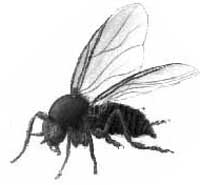 Black flies are similar to miniature horse flies in that they
use blade like mouthparts to cut the skin and feed on blood
that wells up at the bite. The feeding occurs primarily in the
ears and results in crusty, scabby ears and frequently a
head-shy horse. These small flies visit the horse for only a
few minutes, take a blood meal and leave but the scabs
remain for days and the entire front surface of the ear can
be affected.
Black flies are similar to miniature horse flies in that they
use blade like mouthparts to cut the skin and feed on blood
that wells up at the bite. The feeding occurs primarily in the
ears and results in crusty, scabby ears and frequently a
head-shy horse. These small flies visit the horse for only a
few minutes, take a blood meal and leave but the scabs
remain for days and the entire front surface of the ear can
be affected.
Black flies are active during the day and can be a serious annoyance for horses pastured near flowing streams and rivers. Black flies, also called buffalo gnats because of their hump-backed appearance, are strong fliers and can attack horses that are some distance from streams and rivers. The larval stages of black flies develop in flowing water.
Fly wipes can provide protection but a thick smear of
petroleum jelly can provide a protective barrier and
promote healing. It also may be more soothing than the oil
wipe-on. Regardless of the approach, the treatments will
have to be re-applied as long as flies are active.
 MaxForce Granular Fly Bait (Bayer) is available for pest
management professionals and livestock producers. It
contains the active ingredient imidacloprid and can be
scattered, concentrated in bait stations, or mixed with water
for form a paint-on paste. It is primarily labeled for outdoor
use around broiler houses, feedlots, livestock housing
structures, and horse stables. It can be used in walkways of
caged layer houses or in bait stations in horse stables. Bait
stations should be inaccessible to animals.
MaxForce Granular Fly Bait (Bayer) is available for pest
management professionals and livestock producers. It
contains the active ingredient imidacloprid and can be
scattered, concentrated in bait stations, or mixed with water
for form a paint-on paste. It is primarily labeled for outdoor
use around broiler houses, feedlots, livestock housing
structures, and horse stables. It can be used in walkways of
caged layer houses or in bait stations in horse stables. Bait
stations should be inaccessible to animals.
Baits can be used to supplement a house fly control program but should not be the only means of fly control. A bait can be helpful in knocking down house fly numbers but does not compensate for inadequate manure management and a balanced approach to fly control.
Baits usually contain house fly attractants and feeding stimulants. These ingredients must compete with spilled feed, wet manure, and other

Recent samples in the Diagnostic Laboratory have included leaf hopper burn and fungal leaf spots (Leptosphaerulina, Cercospora) on alfalfa; Rhizoctonia crown rot on clover; black shank, soreshin, black root rot, bacterial hollow stalk, target spot, frogeye leaf spot, alfalfa mosaic virus, tobacco streak virus, potyvirus complex, manganese toxicity, nitrogen deficiency, early flowering syndrome, and transplant shock on tobacco.
On fruits and vegetables, we have diagnosed anthracnose, Phomopsis leaf and cane blight, and black rot on grape; anthracnose on raspberry; brown rot and scab on peach; leaf spot and powdery mildew on cherry; Rhizoctonia crown and stem rot on bean; bacterial wilt on cucumber; bacterial spot on pepper; potato leaf hopper injury on potato; and bacterial spot/speck, early blight and Septoria leaf spot on tomato.
On ornamentals and turf, we have seen anthracnose powderymildew and Septoria leaf spot on dogwood;rosette disease on rose; powdery mildew on planetree; Cristulariella leaf spot on maple; anthracnose on bentgrass; necrotic ringspot on bluegrass; leaf rust on fescue; and take-all on mixed turf.

UKREC-Princeton, KY, June 27 - July 3| Black cutworm
| 0
| True armyworm
| 4
| European corn borer
| 1
| Southwestern corn borer
| 0
| Corn earworm
| 0
| | |
NOTE: Trade names are used to simplify the information presented in this newsletter. No endorsement by the Cooperative Extension Service is intended, nor is criticism implied of similar products that are not named.
Lee Townsend
Extension Entomologist